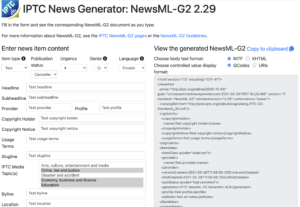Categories
Archives
We are happy to announce a new version of the popular NewsML-G2 generator tool.
This version is easier to use, and shows how NewsML-G2 files can be created using either QCodes or URIs for controlled values. It also allows the user to select the body text format – either NITF (IPTC’s News Industry Text Format) or XHTML. Both formats are used by large news agencies to distribute news content, so using the selector can help you to see the difference between the two formats and perhaps help you to make a decision about which format to use.
The new version of the NewsML-G2 Generator can be accessed at the same URL as the older version: https://iptc.org/std/NewsML-G2/generator/.
Using the NewsML-G2 Generator
To use the generator, simply start typing into the form on the left side of the screen. The grey box on the right hand side will immediately update with the relevant XML markup to represent your content in NewsML-G2 format.
The selectors above the output box on the right hand side allow you to change the output format:
- QCodes vs URIs: Metadata values such as “itemClass” can be expressed either using IPTC’s QCodes format, or by URIs. So for example the “item type” can be expressed as a QCode (<itemClass qcode="ninat:graphic"/>) or a URI (<itemClass uri="http://cv.iptc.org/newscodes/ninat/graphic"/>). This radio button allows you to switch between the two formats for all controlled values in your NewsML-G2 file.
- XHTML vs NITF: NewsML-G2 describes how the metadata around a news item should be delivered, but the actual content of a text news item must be expressed in another format. Two options expressed here are NITF, IPTC’s News Industry Text Format, and XHTML. This radio button changes the <contentSet/> section to include an embedded XML document in either XHTML or NITF format.
More enhancements to come
Currently, the generator tool handles simple text news stories. Ideas for future enhancements are to include support for images, audio and video, packages of multiple news items possibly in multiple formats, the partMeta framework to include metadata about part of a news item, and more. Suggestions are always welcome – please contact us if you have any further ideas.
